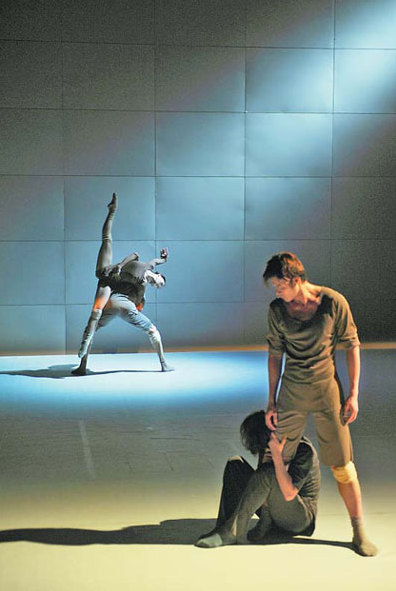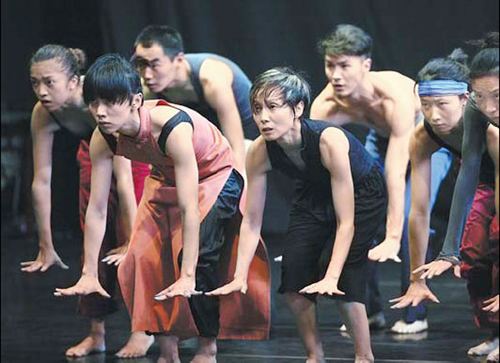
|
|
Founding modern dance troupes respectively in Hong Kong, Guangzhou and Beijing, Willy Tsao is considered a modern dance champion in China. Wang Jing / China Daily
|

|
|
Dancers of Hong Kong City Contemporary Dance Company stage the dance show Blind Chance in Beijing. Cheung Chi-wai / For China Daily
|

|
|
Dancers of Beijing Dance LDTX rehearse the dance drama All River Red. Wang Jing / China Daily
|
Willy Tsao had a visceral reaction to the first performance of modern dance he saw decades ago, and has never stopped making the art form his own, Chen Nan reports.
The first time Willy Tsao watched a modern dance show in Hong Kong in the early 1970s, which was performed by an American dance troupe at Hong Kong Arts Festival, he was instantly hooked.
"When I saw the show, I didn't know what they were doing but I wanted to join them immediately and dance like them," he says.
He describes himself, while watching the show, as a resonating wine glass responding as the dancers swayed to the music.
That became the philosophy of how Tsao found like-minded people - they should resonate with modern dance. But he didn't expect his new love for modern dance to become a lifelong passion.
During the 1970s, young people in their 20s like Tsao, who was born in Hong Kong and educated in the United States, considered the city of Hong Kong as boring.
"There was no entertainment. The only show that everyone loved was the annual Miss Hong Kong Pageant," the 58-year-old recalls. "I felt choked in such an environment."
The first group of people he recruited was 12 dancers who had returned from overseas, with whom Tsao founded the first modern dance troupe in Hong Kong, City Contemporary Dance Company, in 1979.
As the only son in his family, Tsao joined his family's printing and property management business in Hong Kong after obtaining his MBA degree, which allowed him to use his own money to run the company and pay the dancers.
Their first show in 1980 only sold 50 tickets and then the troupe offered free shows at 99 middle schools in Hong Kong that year.
"Back then people didn't know what we were doing. They often associated us with night clubs," recalls Tsao. "We were disappointed but never thought about quitting. We knew the problem and tried to fix it."
Thirty years later, the founding of the dance company proves to be a sound decision.
He founded two other dance troupes in Guangzhou and Beijing. The thin man who is considered a modern dance champion in China now heads three dance companies, leading them on tour around the world every year.
"I don't have big ambition. It was just a young man's dream at the beginning and magically it becomes a shared career. When I look back, it's really unbelievable," he says.
In 1991, he helped set up the Guangdong Modern Dance Company, the first professional modern dance company on the Chinese mainland. Later, he was invited to be artistic director of the Beijing Modern Dance Company in 1999 and in 2005 he founded the Beijing Dance LDTX.
Don't force it
He says that he never forces anything.
"The only thing I told the dancers is that your body is free," Tsao says. "In the past, Chinese dancers limited their bodies because they were told that 'Tibetan dance should be like this' and 'Mongolian dance should be like that'. Modern dance gave them a feeling of liberty."
Tsao got a chance to bring his Hong Kong CCDC to Guangzhou in 1980. Dance had been considered a powerful publicity tool to educate the masses on the mainland then. There were only "red" ballets and folk dances.
So Tsao was ready for some bad feedback. However, when the show opened, he saw more than 1,000 people sitting on long wooden benches, twice the venue's capacity.
The night before they left, a young choreographer came to him and asked many questions about their show and how they danced in Hong Kong.
"He told me that all the spectators loved our shows very much but they had to leave early because they were afraid of being seen by the leaders," Tsao recalls. "I saw how curious they were about modern dance and how eager to know the art form."
That experience motivated Tsao to find - and create - modern-dance fans on the Chinese mainland.
Though during the past few years the art form is finding ways to experiment and grow, the focus for Tsao is still finding audiences in China that appreciate it like himself.
"Compared with those big-budget movies and TV shows, modern dance still belongs to a minority taste on the mainland," he says. "But that's OK. We have a stable amount of people who love modern dance and the number is growing steadily."
With modern dance, Tsao wants to express a sense of individualism. He doesn't want to use technology or big stars to attract audiences.
"It's easy to sell tickets. I could invite Lin Hwai-min or Jin Xing. But what's the point? What I want is those who vibrate with modern dance instinctively," he says.
